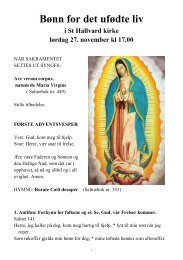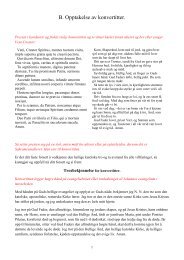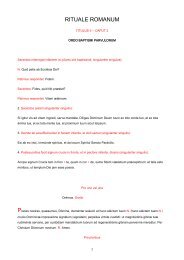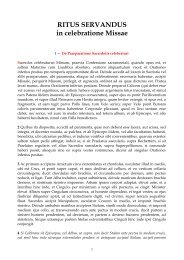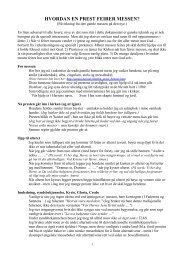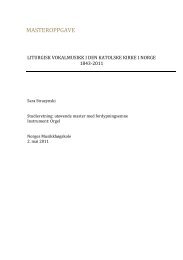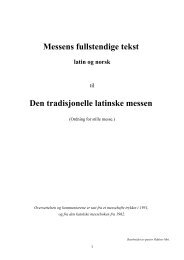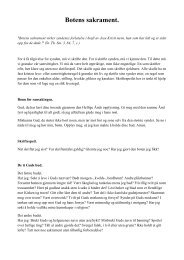HOW THE OLD MASS HAS CHANGED THE WAY I SAY ... - aomoi.net
HOW THE OLD MASS HAS CHANGED THE WAY I SAY ... - aomoi.net
HOW THE OLD MASS HAS CHANGED THE WAY I SAY ... - aomoi.net
You also want an ePaper? Increase the reach of your titles
YUMPU automatically turns print PDFs into web optimized ePapers that Google loves.
<strong>HOW</strong> <strong>THE</strong> <strong>OLD</strong> <strong>MASS</strong> <strong>HAS</strong> <strong>CHANGED</strong><br />
<strong>THE</strong> <strong>WAY</strong> I <strong>SAY</strong> <strong>THE</strong> NEWER <strong>MASS</strong><br />
From the old mass I have first of all taken with me the FOCUS of the priest in the mass - the focus<br />
on God, on offering up to God the perfect sacrifice of Christ – making all other things less<br />
important.<br />
The vesting prayers in the sacristy help the priest with this focus - showing him his own<br />
unworthiness and need for God's help and grace. I end these prayers with "Ego volo celebrare<br />
Missam, et conficere corpus et sanguinem Domini nostri Jesu Christi, … " expressing what the<br />
mass is. Then I walk into church with this same focus - not looking at people. With this same focus<br />
I genuflect before the altar, praying "Aufer a nobis ..." as I walk up to the altar, and "Oramus te,<br />
Domine .." as I kiss it – these are prayers asking for purification and forgiveness of my sins. As I<br />
kiss the altar at the end of mass I have also taken from the old mass the prayer "Placeat tibi ...". This<br />
prayer sums up very well what the mass is all about: "May the tribute of my humble ministry be<br />
pleasing ..." and "Through your mercy may it bring forgiveness to me and to all for whom I have<br />
offered it".<br />
So the main contribution from the traditional mass in on the FOCUS it gives the priest. In the<br />
following paragraphs I will also mention some more details about how the traditional rubrics help<br />
keep this focus:<br />
SPEAKING AT <strong>THE</strong> BEGINNING AND END OF <strong>MASS</strong><br />
I now only use the traditional form of the greeting: "The Lord be with you." I do not say anything<br />
about the mass at this point, except sometimes the name of the saint we celebrate. I may also say the<br />
name of the persons I offer the mass for, if I have a special intention and people want it mentioned.<br />
(I also use the full "Confiteor" at this point, but that is really the case with all Catholic masses in<br />
Norway.)<br />
The most important teaching from the traditional mass when it comes to speaking is that the priest<br />
should say absolutely nothing of his own (outside the sermon). But at the end of mass, I<br />
occasionally give a few necessary and short announcements after the post-communion prayer. If I<br />
need to say something more lengthy, I do so just after the gospel is read.<br />
EUCHARISTIC PRAYERS<br />
I now use EP-I 95% of the time – a few times I use EP-III. In EP-I I always use the optional (4<br />
times) [Through Christ our Lord.], which actually makes quite a bit of a difference – and as far as I<br />
know very few priest include these options.<br />
1
HANDS<br />
It helps the priest quite a bit in his focus in the mass to hold/use his arms and hands according to the<br />
rubrics of the TLM. I hold my hands together in front of my chest, put the left hand put down flat<br />
on the altar when only right hand is used, to turn pages etc., inside or outside the corporal, all<br />
according to the old rubrics. I also make the sign of the cross at the end of the Gloria and the Creed,<br />
and at the Benedictus in the Sanctus.<br />
FINGERS<br />
I only partly hold thumb and index finger together after the consecration – I do when I touch other<br />
things (the missal, when I strike my chest etc.) but not completely according to the old rules. Maybe<br />
I should, but it becomes too complicated when the altar servers don't know about this. (I am not a<br />
parish priest – since I am a married man, a former Lutheran minister – and have little influence over<br />
how the servers are trained. When I say the traditional mass about twice a week I have properly<br />
trained servers, of course.)<br />
EYES<br />
I the old mass the priest is never supposed to look at people, except during the sermon; he faces<br />
people a few times, but with "his eyes cast down"<br />
When celebrating the new mass I follow this rule for the most part, but look more directly at the<br />
people 4-5 times (and no other times) when I say "The Lord be with you", Let us pray, "Orate<br />
fratres .." and "The peace of the Lord be with you always."<br />
In the old mass it is also specified that the priest should look at the host (constantly) as much as<br />
possible after the consecration. I follow this rule in the new mass now, and it has changed the way I<br />
celebrate the mass considerably.<br />
HEAD<br />
Influenced by the old mass I now bow my head every time the names Jesus and Mary are<br />
mentioned, and at the name of the Holy Father in the Eucharistic prayer, and the name of the Saint<br />
celebrated that day. I also bow my head the three extra times in the Gloria and at the "simul<br />
adoratur" in the creed.<br />
I also make a deep bow during the whole "Confiteor" and the "Et incarnatus est … " in the Creed.<br />
CHALICE AND CIBORIUM<br />
2
In Norway several priests tend to use the palla during mass, but they take it off/ put in on the chalice<br />
in a non-traditional way (like it is done in the Vatican, I think). I now use the palla as it is<br />
prescribed in the old mass.<br />
Some ciborium are of the old kind with a lid, but the lids tend to be left on the credence table and<br />
not at all used during the mass. Now I follow the rules of the old mass, I use the lids and take them<br />
off only during the offertory and at the consecration of the host.<br />
I always use a chalice veil and a burse – such veils are often used in Norway now (they are<br />
gradually coming back), but not burses.<br />
GENUFLECTING<br />
I do not add any genuflections to the rules of the new mass – nor any signs of the cross over the<br />
chalice and host.<br />
PURIFICATION<br />
I do not (yet) purify the chalice and other sacred vessels according to the old rules, but I do purify<br />
the paten with my right index finger, and I do purify the fingers of my right hand over the chalice.<br />
(See here also the paragraph about "fingers" above.)<br />
VESTMENTS<br />
I always cross my stole, like in the old days, but I do not wear a maniple when I celebrate the new<br />
mass. I have recently started to wear a biretta for all masses. This last thing seems to be even more<br />
important for people than for the priest; some reactions I have received about the biretta is that it<br />
makes mass look like "serious business", meaning (I think) that it helps people focus better on what<br />
the mass really is.<br />
Oslo, Norway, 31 March 2011 – Fr. Oddvar Moi<br />
3



